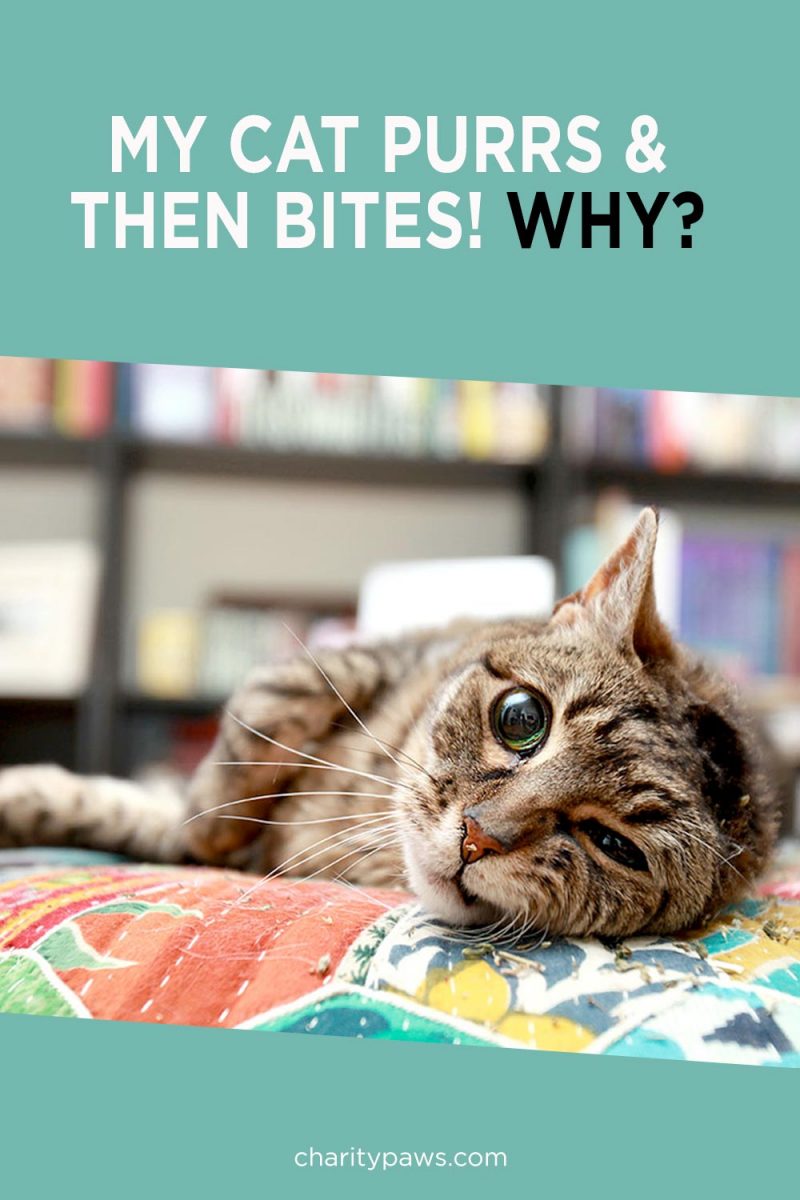Cats are sometimes really hard to read – that is for sure! If you have ever wondered why do cats purr and then bite you – I am going to try and break it down for you.
You are enjoying a special moment with your cat – gentle head rubs, a moment on the belly all which seem to make her happy since she is purring loudly. But then – out of nowhere they go on attack mode and give you a big old bite on your hand and the back feet start flailing. What they heck?
Always a subject that cat owners are curious about! If your cat bites you for no reason it can be a sign of overstimulation from your constant petting.
Aren’t They Love Bites?
While some consider it a love bite – the truth is it usually is not about love.
Some cats by nature love being petted and loved on more than others – but the purr to bite phenomenon is one most cats seem to do. So if your cat is doing this – just know you are not alone.
Even when I created a fundraising calendar for a local cat rescue – I thought I was becoming close friends with many of the cats I photographed because they would let me love on them and purr away – but sadly, I was wrong. I usually left those sessions with more scratches and bites than I expected! But I would do it all over again for those few minutes of awesomeness!
But Why Do Cats Bite Exactly?
Cat bites are typically a sign of overstimulation. When cats have had enough of your affection or are overstimulated, they will let you know by pushing away with their feet or giving you a bite.
Some also believe that little electric shocks from repeated stroking can affect your feline friend and cause them to react as well. So be sure to mix up how and where you are rubbing them to try and limit the chance of this happening.
For some cats it can also be a little sign of hey – play with me. I know my own cat will hop on the bed give me a nip and flop down for some love. But then – when I have worn out my welcome for attention she will bite me a bit harder to get me to stop – and of course I do.
Typical Signs Of Cat Overstimulation
Below are some of the more common signs of overstimulation in cats that can lead to those cat bites. When you can see the signs and back off from the petting – you can prevent these bites from happening.
- Cat fur begins to twitch
- Ears flickering or turning back/folding
- Restlessness
- Tail swinging hard or twitching
- Eyes getting large or pupils dilated
- Body gets more tense and less relaxed
- Some cats may be vocal when they have had enough
- Arching of the back
Tips For Preventing Cat Bites
Whether you have had a cat for years or just rescued a new family addition – understanding each cats’ unique needs in terms of attention is critical to ensure you have the best relation possible with your cat.
- Observe the signs of overstimulation. Most times your cat will give you a sign they are getting close to having enough petting or holding, so make sure you know to read those signals. Usually a tail swinging back and forth, flattening of their ears or some skin twitching will be the signs they will give to say “hey I have had enough”.
- Do not rush to pet again. Give them some time to calm down and make sure all the signs they were showing are gone before trying again. Some cats will need longer to calm down than others so make sure you really get to know your cat and what they need before proceeding again to try and pet or hold them.
- Find the spots they enjoy being rubbed. Just like people – every cat likes touch in different places. Some love bellies, some hate bellies. My cat – she LOVES LOVES LOVES her head rubbed as hard as I can. This is the one spot I can spend more time on than any other – so that is where I focus my petting.
- Limit the time you spend petting. Especially if you have a new cat and you are not sure what their limits are, spend your petting time in short spurts and increase slowly to see how much they will tolerate. If you try to pet them for longer than they enjoy you risk harsher biting and scratching – so it is important to find their “happy” time to be touched. For some it could be several minutes, some could be a few seconds!
How To Handle A Cat Bite
Your goal is to actually note get bit by adhering to the guidelines above, but if your cat does bite what should you do next? First, stop petting them and move your hand away. Let them relax – or run away if that is what they choose to do. Do not chase them – just let them go so they can decompress.
If they stay near you – the just leave them be and let them take the next steps. In a few minutes you may find them rubbing against you to get a few more rubs – or they may just want to be by your side with no real interaction.
The goal is to let them be the boss! If you adopted a cat, then you know – this is what you signed up for!
Oh – and don’t forget if the bite or scratch left a mark you may want to go wash it out! Remember, cats walk in litter boxes and their paws can be filled wit yucky stuff – so better safe than sorry.
What To Do If Your Cat Bites Too Much?
If your cat tends to lean on the aggressive side you definitely want to use more caution to prevent any severe scratching or biting issues. If every time you play with your cat they are on your hands biting or scratching it may be time to adjust their play to be more toy based.
If your cat has always been welcoming to pets and cuddles in the past and the biting is a new issue, you may want to consider that they may not feel well or are in pain. A visit to the vet may be a good idea to rule out any illnesses for this new issue.
Not every cat enjoys the touch of people and find even a few seconds are a few seconds too much. You can try to pet them with a soft glove of some sort to limit your chance of getting hurt if you want to try and get them used to touch. You can also try a cat calming spray and cat specific calming products like the Relaxivet Diffuser.
How Do I Really Know If My Cat Loves Me?
So if cat love bites are not true signs of love – you may be wondering how cats show they care. Research done at the Human-Animal Interaction Lab at Oregon State University shows proof that cats form strong attachments to their owners – contrary to what many people think! In an interview with the lead author of the study, Kristyn Vitale, she found that cats do in fact use their owners as a source of security – that alone, is a show of love!
How do they show their affection in ways you can understand?
- Purring when they are near you.
- Grooming you is also a sign of love – when they lick you not only does it help them feel more relaxed but it shows trust.
- Belly up is a sign of trust and a sign that they are happy to see you, and while you may want to jump in and rub that belly – you may be surprised when they try to push you away!
- Head butts (which are my favorite thing ever) – are one of their most common ways of showing love and trust. This is also how they mark their territory and shows you she/he belongs to you!
- Slow blinks are considered to be a sign that your cat enjoys having you around and that they love you. Rumor is that you can blink back slowly and they will understand you love them too.
For those of us that love cats – we know they can sometimes be a bit fickle in their behaviors and want what they want when they want it. But cats are truly as loving as dogs and even kids – they just sometimes show it in funny ways!
What do you think – can cats really show or feel love?
How does your cat show you love?



I think some bites are love bites. My cat only ever bites me extremely gently. She doesn’t put pressure down, just lightly mouths me. Usually when I’m giving her kisses, she will very lightly bite my hand. I think this is her returning the kisses.
Awwww your baby sounds like she is one happy kitty!